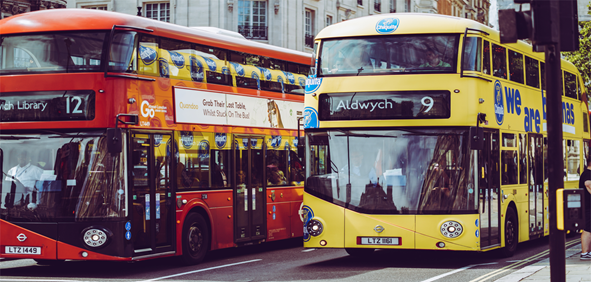
Public Transportation Fare Model is not transparent — Here’s some key insights for Fare calculation
Last Updated on August 26, 2021 by Editorial Team
Author(s): Supriya Ghosh
Mathematics
Public Transportation Fare Model is not transparent — Here are some key insights for Fare calculation

Fixing fare for a public transportation system is very challenging and is always inclined towards social service or public welfare.
Although there are multiple modes of public transport in this write-up, I will take up the case of a Bus Fare Model.
With fluctuating currency and fuel prices and increasing cost of spares, the operating cost for public transport is on the rise. But increasing fares is not always possible because of economic conditions and political compulsions.
So, when operating costs are on rising and is not accompanied by a proportionate increase in fare, what happens is:
The profit margins start coming down and when margins come down, it directly hits the operators/owners of the Buses. That is the reason a proportionate increase in fare is always desirable with an increase in cost to balance margins and in turn revenue.
But attached to this one more issue is that if fare increase happens very frequently to compensate for revenue losses, then people who are coming from quite far distances and are traveling by multiple connecting buses, for them the transportation costs become very high. Sometimes it becomes so high that they do not want to travel at all. Rather they stay back in their hometown and work from there.
So, what happens, in the long run, is, the income per head or the per capita income of these people also comes down. And when per capita income comes down it hits the savings of the individual and the growth rate of the economy.
So, increasing fares is related to multiple aspects and cannot be exercised frequently.
This calls for a rational approach towards an automatic increase in passenger fares that responds to market fluctuations of input costs and at the same time do not put the general commuters to economic discomfort. So, somewhere we have to strike a balance.
The buses are generally owned and operated by private payers. But just to prevent them from charging arbitrarily from the commuters, the fares are controlled by the government.
We will deal with one of the Basic approaches on how to fix fares in a public transportation system.
Although there are few more methods, I will focus on the “Formula based Empirical approach” for our computation as it is one of the most widely used methods.
Before I start with the Empirical approach let me give an approximate breakup of the Cost component of the Bus Transport system.

Let us now calculate multipliers for each component individually.
Multiplier depicts a numeric value related to each component which is derived for further calculation.
1. Fuel Multiplier for Fuel Cost
To compute, Fuel multiplier, we need to consider two factors, the first is the Fuel Price increase Rate and 2nd is Efficiency Equation.

This represents how many times the fuel Price has increased since the previous fare revision.

This represents the current Fuel Efficiency of the Bus. This keeps changing based on Fuel efficiency achieved by Bus in different road and traffic conditions.
The numeral 4 is computed by another method using Linear Regression which we will not discuss now. I plan to write a separate article to cover the same.

2. WPI (Wholesale Price Index) Multiplier for Operations and Maintenance Cost

This represents how many times the WPI has increased since the previous Fare revision.
3. CPI Multiplier for Staff and Other Cost

This represents how many times the CPI has increased since the previous Fare revision.
4. Investment Multiplier for Capital Cost
Investment Multiplier =

This represents how much the Actual Capital cost of Bus varies with reference to the Standard Cost set as a baseline.
Let me elaborate on this further.
Suppose Actual money spent to purchase the Bus is 3 million and the Standard or a baseline set by Government authority is 2.5 million for that category of Bus, then our Investment Multiplier becomes 3/2.5 = 1.2
Hence the final Empirical formula for Fare increase is given by :
Fare Revision Multiplier = 0.5 * Fuel Multiplier (+) 0.1 * WPI Multiplier (+) 0.25 * CPI Multiplier (+)
0.15 * Investment Multiplier
Where 0.5, 0.1, 0.25, and 0.15 numerals multiplied with Multipliers represent a share of individual cost components depicted in the table above.
This can also be represented as :
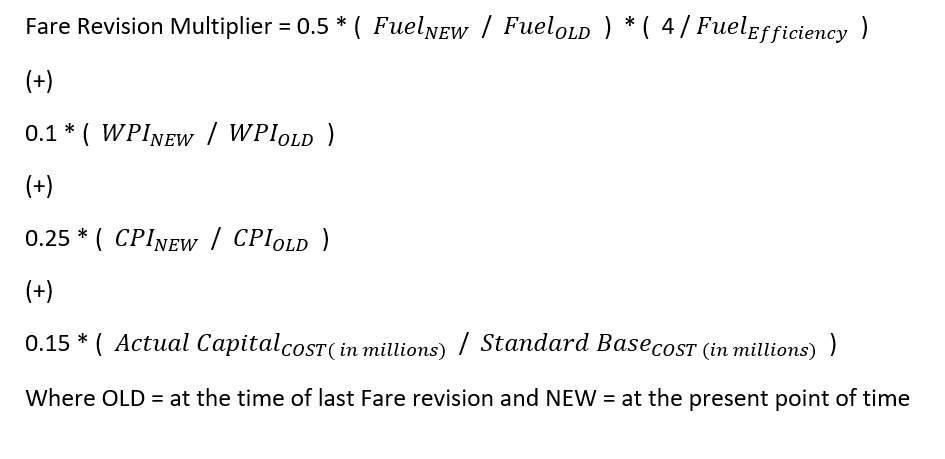
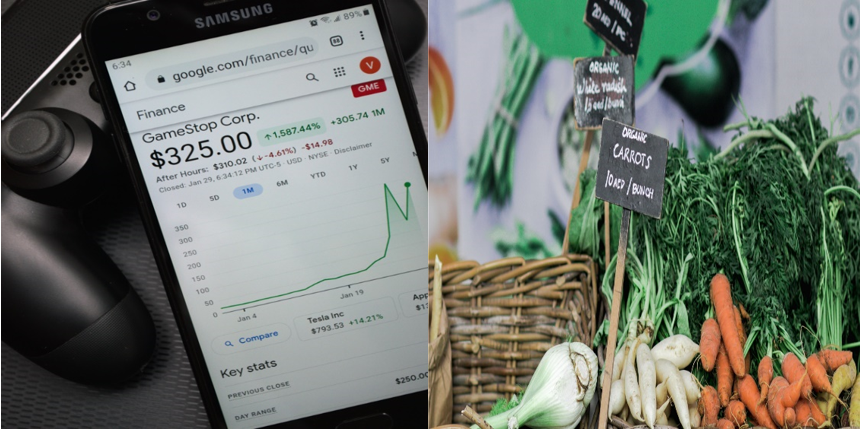
Now let us consider an Illustration depicting a Case.
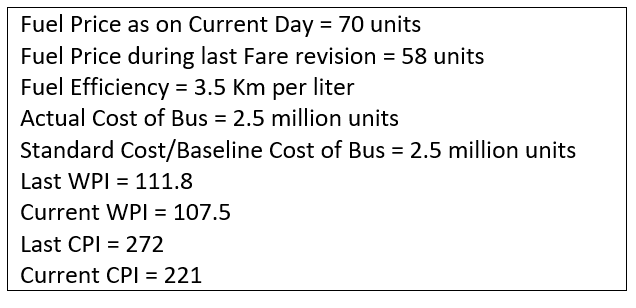
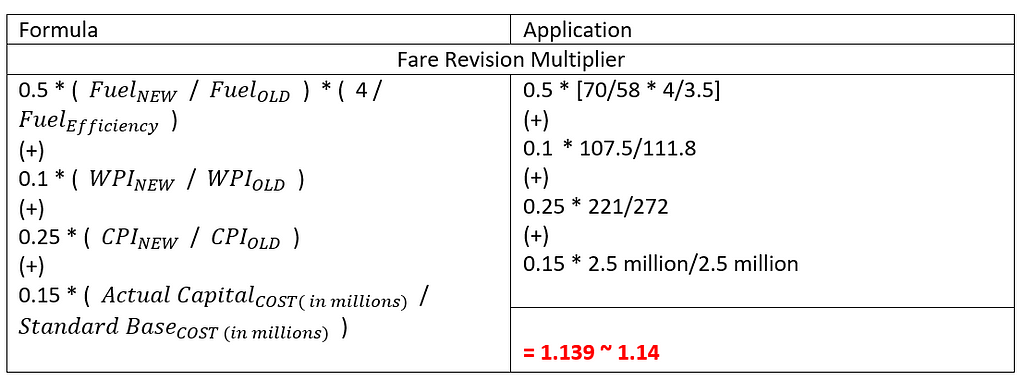
Computing the New Fare for different Fare slabs/Stages from above computed Fare Revision Multiplier

The below table depicts the Fare Revision (New Fare) computed at different multiplier ranges.
Fare Stage and Fare are chosen arbitrarily and can be customized as per needs.

The standard Fare values are computed by multiplying lower multiplier range in each column with base fare value. For e.g.- for the 1st stage fare, the first column multiplier range, 1.01 is multiplied by Fare value 6.
i.e. — 1.01 * 6 = 6.06
Similarly, for the second column multiplier range, it is 1.11 * 6 = 6.66.
For 2nd stage fare and second column multiplier range, it is 1.11 * 8 = 8.88 and so on.
As per the multiplier computed in our illustration i.e., 1.14, it lies in the range 1.11–1.20, hence the green highlight in the above table gives the New Fare after revision.
Disclaimer — There are multiple methods to compute Fare and are used depending on the situations and circumstances. Here I have shown one of the simplest ways for calculation. However, every country or state, have their own standard methods for calculation. But this certainly will give some insights to understand the fundamental concept.
With this, I conclude.
Hope you enjoyed going through this model.
You can follow me on LinkedIn: Supriya Ghosh
And Twitter: @isupriyaghosh
Public Transportation Fare Model is not transparent — Here’s some key insights for Fare calculation was originally published in Towards AI on Medium, where people are continuing the conversation by highlighting and responding to this story.
Published via Towards AI
Take our 90+ lesson From Beginner to Advanced LLM Developer Certification: From choosing a project to deploying a working product this is the most comprehensive and practical LLM course out there!
Towards AI has published Building LLMs for Production—our 470+ page guide to mastering LLMs with practical projects and expert insights!

Discover Your Dream AI Career at Towards AI Jobs
Towards AI has built a jobs board tailored specifically to Machine Learning and Data Science Jobs and Skills. Our software searches for live AI jobs each hour, labels and categorises them and makes them easily searchable. Explore over 40,000 live jobs today with Towards AI Jobs!
Note: Content contains the views of the contributing authors and not Towards AI.















